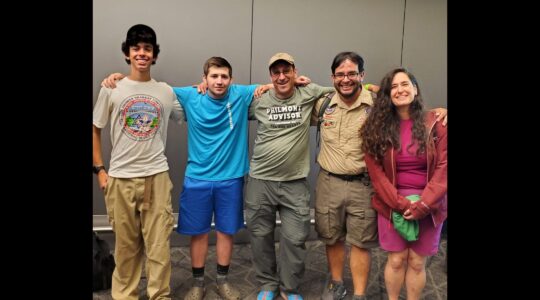
Dylan Siegel, 14, wearing his great-grandfather’s tallis. ()
(JTA) — In his 2003 memoir “Lessons for Dylan,” Joel Siegel, the late film critic for ABC’s “Good Morning America,” asked that his young son someday sing the Shema prayer.
“But, when you finish,” he wrote, “think about applauding on the inside.”
Siegel passed away in 2007 after a 10-year battle with cancer. Had he lived, he would have been applauding at the recent early Saturday evening service when his only child completed his nontraditional journey to becoming a bar mitzvah.
Growing up in New York with his mother, the artist Ena Swansea, and stepfather, Antoine Guerrero, Dylan, 14, had no formal Jewish education (nor did the family belong to a synagogue) before beginning his bar mitzvah preparations a year-and-a-half ago.
For Swansea, a Quaker, the task was especially daunting. “It’s been a journey for us. We didn’t know where to begin,” she said. “Joel wanted very much for Dylan to have a bar mitzvah, and I promised him I’d do that. But it took awhile to find a way that suited Dylan.”
Swansea started by contacting Rabbi Larry Raphael, a childhood friend of Siegel’s in San Francisco, for assistance. Raphael put her in touch with Rabbi Kim Geringer of Congregation Sha’arey Hayam in Manahawkin, N.J., and a faculty member at the Hebrew Union College-Jewish Institute of Religion in New York.
“I was really moved by what they wanted to do,” said Geringer, who began Dylan’s journey to bar mitzvah by assigning him, and Swansea, books to read, including “A Topical Bible,” and several articles on Jewish ethics.
During discussions about the material, the conversation would frequently come back to Siegel, who wrote in his book of the time he spent with the Rev. Martin Luther King Jr. and working on behalf of civil rights in the South during the 1960s.
“It was really wonderful to make the connection [between] the underlying ethics and Joel’s life and his values,” Geringer said.
The plan was for the bar mitzvah ceremony to include a full Sabbath afternoon Torah service followed by Havdalah. But, the rabbi says, it was important that the event remain “true to who Dylan is and his needs, yet still be true to the proper way to have a service.”
To prepare Dylan for the parts of the bar mitzvah that would be in Hebrew, the rabbi enlisted her daughter, a teacher at the Cathedral School in New York and a b’nai mitzvah tutor at the city’s Central Synagogue, to help him learn how to read the language. For more than a year, she and Dylan met on Sunday afternoons, using the tried-and-true Hebrew primer “Aleph Isn’t Tough.”
The preparations culminated with an April 14 service and reception, both in the family’s New York loft.
For his Torah portion, Dylan prepared a traditional speech, but also tapped into his creative side by writing a play complete with “music, lights, actors and props.” He cast his uncle and cousin to perform.
“The play was the best,” said Dylan, an eighth-grader at City and Country School in New York. “I wanted to explain the story [Parshat Shemini] in a way that people would remember and make it visual.”
Also during the service, Siegel’s sister passed on to Dylan her grandfather’s tallit, while another cousin read a text about the meaning of the prayer shawl.
As a guide for the 125 guests — a “marvelous mix of people,” Swansea said — a program was created for the service with the traditional liturgical texts interspersed with photos of father and son, and excerpts from Siegel’s book, including his grandmother’s brisket recipe, a “closely held family secret.”
“We wanted to put [the recipe] in the program because it meant so much to everyone and to Joel,” Swansea said.
A photo of Siegel cutting a cake in the shape of a Torah at his bar mitzvah in 1956 was included, too. And as a tasty tribute to Dylan’s father, Swansea commissioned a baker to make an identical vanilla Torah cake with passion fruit butter icing for Dylan. It was served at the reception following the service.
“Honoring his dad’s wishes and dedicating himself to doing this tells me that [Dylan] is a different kind of young man,” said Andy Clayman, a guest and family friend. “Inwardly he’s showing that he is responsible beyond his years, and outwardly that he’s very creative.”
Those present at the bar mitzvah “knew who we were honoring and thinking of,” Swansea said. “It was very personal and unique, and also traditional, and affected a lot of people.”
And Siegel, she adds, “would have been very, very pleased and proud of Dylan.”
(The LifeCyclist column is dedicated to covering the ways that individuals and families are marking important Jewish milestones in their lives. Please send suggestions for future coverage to LifeCyclist@jta.org.)
JTA has documented Jewish history in real-time for over a century. Keep our journalism strong by joining us in supporting independent, award-winning reporting.





